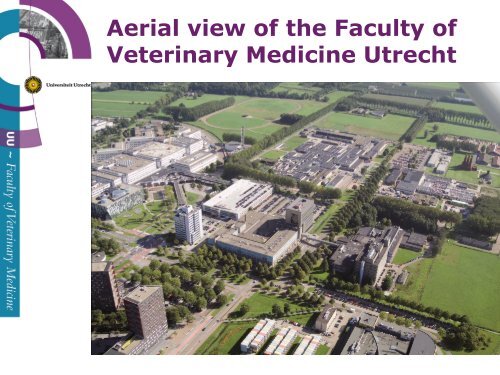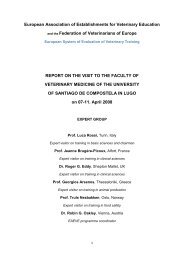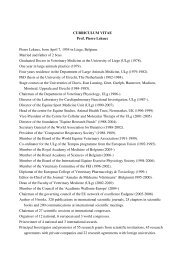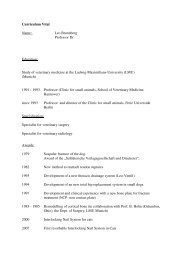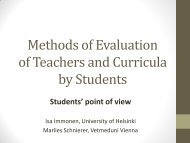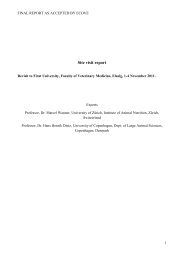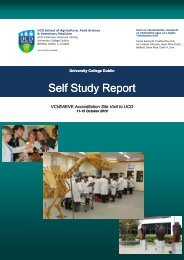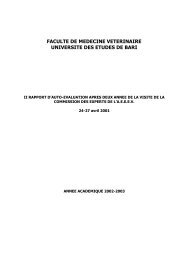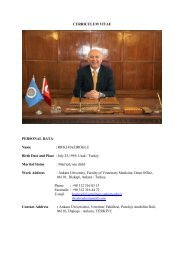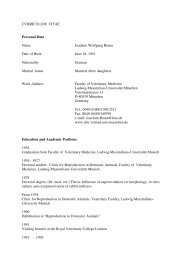Animal Welfare - EAEVE
Animal Welfare - EAEVE
Animal Welfare - EAEVE
- No tags were found...
You also want an ePaper? Increase the reach of your titles
YUMPU automatically turns print PDFs into web optimized ePapers that Google loves.
Aerial view of the Faculty ofVeterinary Medicine Utrecht
The role of a veterinarian inthe next 30 yearsAnton PijpersUtrecht University
Content• What’s happening around us– In general– Societal demands– Food producing animals– Companion animals– Other• Role of veterinarians• Consequences for veterinary education
General trendsDrivers of change affecting the food system (FAO, 2011)• Global population increases• Changes in the size and nature of per capita demand: meat,fish, regions• Future governance of the food system at both national andinternational levels• Climate change• Competition for key resources:– Land for food production– Global energy demand– Global water demand• Changes in values and ethical stances of consumers:acceptance of modern technology, production methods,animal welfare, biodiversity protection, fair trade
General trends• Need for animal proteins worldwide– 9 billion people in 2040– Consumer spending power, BRIC-countries– Growth in meat production and consumption,especially poultry– Sustainable production systems• Farm(er) specialisation• Differences within Europe
General trends• Information technology, open knowledge world• Global world, all travelling around• Global world market and trade• (re)Emerging diseases• Value of animals is increasing• Importance of biomedical research is increasing• Quality systems are integrated and accepted inevery part of the food chain or transparant forclients.
Societal demands• Differences within Europe• Healthy animals• EU-notifiable diseases, vaccination policy• <strong>Animal</strong> welfare• Public health, One Health, food safety,sustainable production• Emotions vs ratio• Checks and balances, need for quality systems
Food producing animals• Consolidation of animal agriculture, shift to eastern-Europe• Larger livestock enterprises– Fewer farms– Great economic importance– “Non-acceptance” in western society, in crowded regions– Sustainability of the sector in discussion– Dedicated care-givers, technicians to be trained– <strong>Welfare</strong> issues and discussions• Underserved rural areas for economic and socialreasons• Cost-driven vs added value: desire for locally grown foodor biological products• License to produce: suboptimal production due todifferences in health status, housing conditions,management, well-being
Companion animals/ equine• Increased importance of individual animals• High expectations for services like in humanhealth care• 1e, 2e, 3e-line services• Differentiation and specialisation continues• Number of visits/yr/animal decreases• Increasing costs, assurances??• More preventive healthcare– DNA technology: genetic profile, personalised care– Food technology: disease prevention, nutritionalguidelines
Other• Wildlife services and monitoring• Biomedical research– comparative medicine of multiple species• Industry– Pharmaceutical– Food producing• Human health, One health• New diagnostic techniques
<strong>Animal</strong> <strong>Welfare</strong> – animal centered?The five freedoms (Brambell, 1967)Freedom from thirst and hungerFreedom from discomfortFreedom from pain, injury, and diseaseFreedom to express normal behaviorFreedom from fear and distress‘Negative’ emotions compromise welfare?Free from ‘negative’ isn’t ‘positive’ still?What is biological functioning?
<strong>Animal</strong> <strong>Welfare</strong> – animal centered:the freedom adequately to react to• hunger, thirst or incorrect food,• thermal and physical discomfort,• injuries or diseases,• fear and chronic stress,and thus, the freedom to• display normal, species-specific behavioural patterns,which allow the animal to ADAPT to the demands of theprevailing environmental circumstances to enable it to reach astate which it perceives as positive.(Ohl & van der Staay, TVJ, 2012, 192:13-19)
<strong>Animal</strong> <strong>Welfare</strong> – animal centered?cognitionadaptive/nonadaptiveperceptionofinner statepositiveemotionnegativeemotionenvironment
Public Health – One Health– (emerging) Zoönoses– Antimicrobial resistance– Food safety– Environmental security– Basic principles in biomedical research• Vaccine-technology• Cell-biology• Regenerative medicine• Cancer research• etc
Content• What’s happening around us– In general– Societal demands– Food producing animals– Companion animals– Other• Role of veterinarians• Consequences for veterinary education
Vet – “Public health servant”Primary role in serving society!!Role at the interface of animals, humans andenvironment:- (emerging) Zoönoses- Antimicrobial resistance, what are the facts?- Food safety- Environmental health, sustainable food production- Not only in food producing animals but also incompanion animals!!
Vet –“<strong>Animal</strong> health specialist”• Traditional role as a clinician– knowledge of healthy and diseased animals• Focus on prevention• Monitoring and surveillance of diseases• Population medicine, data-analist: epidemiology• Supervising technical services• Diagnostic innovations• Risk analysis – disease, public health• Integrated problem-solving• Academic approach
Vet – “<strong>Animal</strong> welfare protection”• Advocating the well-being of animals• Scientifically founded position• Knowing various animal welfare concepts• Knowledge regarding the legal and socialcontext of animal welfare• Evaluating the welfare of the animal andrecognises possible abuses (housing,stewardship)• Advice how to improve welfare conditions
Others• Basic: Comparative medicine in multi-species• Wildlife• Industry: Food, feed, pharma• Biomedical Research:• Vaccine-technology• Cell-biology• Regenerative medicine• Cancer research• Pharmacist? Distributor of vet.medicines?
The future veterinarian• Is not anymore a single hard-workingpractitioner mainly busy with animal health in allspecies;• A health care professional with self-confidenceon serving society, problem-solving andintegrating disciplines with other professionals• Critical thinker with self-reflection• Advisor in food production chains, plays a role tomake food production systems sustainable• <strong>Animal</strong> health and welfare ‘specialist’• Focus on the concepts of One Health
The future veterinarianBased on knowledge and primary skills ofpublic health and animal health and animalwelfare for different species:• is serving society• as an advisor, coach, consultant withspecialised added value, delivering highervalue services• collaborating with other professionals, andtaking his or her role!!!
Professional competences• Academic attitude, analyze and interprete• Collaboration• Communication• Leadership: spokesman on animal issues,leader in animal/human interface• Business management, marketing• Ethical standards
New graduates• The transition to first employment is acritical one.• Early negative experiences demotivatesworking in (farm animal) practice• Attractive work under supervision andworking as “vet-in-education” can help• Continuing professional development toimprove and broaden professional skillsand personal qualities
Content• What’s happening around us– In general– Societal demands– Food producing animals– Companion animals– Other• Role of veterinarians• Consequences for veterinary education
General• Added value of veterinarian• Differentiation-tracks-Specialisation• Life-long learning• Competencies• Centers of excellence?
Added value of the veterinarian• Basic:– Healthy vs diseased– Basic biomedical clinical expertise related tothe future differentiation– Individual and population– Comparative medicine in multi-species• <strong>Animal</strong> Health “specialist”• <strong>Animal</strong> welfare protection• One Health: the role at the interface ofanimals, humans and environment
Differentiation-Specialisation• The vet should have an added value for (specialised)clients• Knowledge is exploding in an open world: study load?• Basic biomedical expertise related to the futuredifferentiation• Basic general primary skills• (MSc-) tracks to differentiate• Recognised by clients/market• Quality assesments of schools and vets!! Vet.schoolstogether with profession in the lead.• General diplome: certified vets, not qualified to performall treatments (?differentiated diploma’s?)• Change in career: back to tracks, life long learning
Competences• Veterinary expertise:– <strong>Animal</strong> health– <strong>Animal</strong> welfare– Public health, One Health• Communication• Collaboration• Business management, marketing• Personal, leadership and academicattitude
Centers of excellence• Can every School provide alldifferentiation?• Basics and theory: yes• All differentiations possible?– Schools provide tracks depending onpossiblities: clinical training, specialised crew(also international experience)– Recognised and accepted qualityassessment!
Change management ofvet.schools• There are changing external demands for the futureveterinarian:• How flexibile are we to react on changed demands?Other focus and new things in the curriculum arerequired!• Too much to know and to learn: we have to choose, butwhat are we not going to choose or to do?• Is our staff flexible in thinking about:– the changing skills and outcome assessments of our graduates– and the consequences for the curriculum?• A thorough quality system is a must!• Influenced by external circumstances: there must alwaysbe an open mind for change! That’s quality management• We, as deans, must tell the story and do it, that’sstrategic leadership!
Conclusion• Beautiful profession with good image andreputation• Lots of possibilities in the future• Much more than a traditional veterinarypractitioner• More consciousness on serving society• Leadership in animal health, animal welfare,One health, wildlife• Other skills and competencies requested• Basic veterinary knowledge combined withdifferentiation: added value!!• Open mind for changing possibilities• Recognised quality systems!
The future veterinarianBased on knowledge and skills of animalhealth, animal welfare and public health :• is serving society• as an advisor, coach, consultant withspecialised added value, recognised byclients• collaborating with other professionals, andtaking his or her role!!!
Thank you


